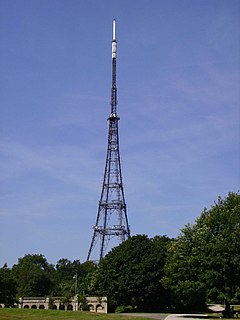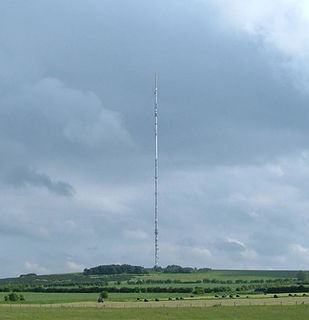
Terrestrial television is a type of television broadcasting in which the television signal is transmitted by radio waves from the terrestrial (Earth-based) transmitter of a television station to a TV receiver having an antenna. The term terrestrial is more common in Europe and Latin America, while in the United States it is called broadcast or over-the-air television (OTA). The term "terrestrial" is used to distinguish this type from the newer technologies of satellite television, in which the television signal is transmitted to the receiver from an overhead satellite, cable television, in which the signal is carried to the receiver through a cable, and Internet Protocol television, in which the signal is received over an Internet stream or on a network utilizing the Internet Protocol. Terrestrial television stations broadcast on television channels with frequencies between about 52 and 600 MHz in the VHF and UHF bands. Since radio waves in these bands travel by line of sight, reception is limited by the visual horizon to distances of 40–60 miles (64–97 km).
Television in New Zealand was introduced in 1960 as a state-run service. The broadcasting sector was deregulated in 1989, when the Government allowed competition to the state-owned Television New Zealand (TVNZ). There are currently three forms of broadcast television: a terrestrial (DVB-T) service provided by Freeview; satellite services provided nationwide by both Freeview and Sky; and an internet television service delivered over cable and fibre broadband.

The Crystal Palace transmitting station, officially known as Arqiva Crystal Palace, is a broadcasting and telecommunications site in the Crystal Palace area of the London Borough of Bromley, England. It is located on the site of the former television station and transmitter, operated by John Logie Baird, from 1933.

The Mendip transmitting station is a broadcasting and telecommunications facility on the summit of Pen Hill, part of the Mendip Hills range in Somerset, England, at 305 metres (1,001 ft) above sea level. The station is in St Cuthbert Out civil parish in Mendip district, approximately 2 miles (3.2 km) northeast of the centre of Wells. It has a 281.6 metres (924 ft) tall mast, which was built in 1967 and weighs around 500 tonnes, and is the tallest structure in South West England. The mast broadcasts digital television, FM analogue radio and DAB digital radio, and had broadcast analogue colour television from 1967 until 2010. It has become a Mendip landmark, providing a method of identifying the hills from a distance.
Digital terrestrial television in the United Kingdom encompasses over 100 television, radio and interactive services broadcast via the United Kingdom's terrestrial television network and receivable with a standard television set. The majority of digital terrestrial television (DTT) services, including the five former analogue channels, are broadcast free-to-air, and a further selection of encrypted pay TV services are also available.
Analogue television in the United Kingdom includes terrestrial, satellite and cable services that were broadcast using analogue television signals. Following the termination of Virgin Media's analogue cable television service in Milton Keynes in November 2013, all television in the United Kingdom is broadcast in digital only.

Ferryside television relay station is a small TV relay in the village of Ferryside, Carmarthenshire, Wales. The Ferryside relay is fed with the off-air signal from Preseli about 28 km to the northwest. It is one of the few UK broadcasting transmitters using a wooden pole as aerial tower. It was built in 1985 partly to provide a stronger signal to Ferryside itself, but also to lower Llansteffan on the western side of the estuary which could not receive a usable signal either from Preseli nor from Carmel about 22 km to the northeast.

The Rowridge transmitting station is a facility for FM radio and television transmission at Rowridge on the Isle of Wight in southern England.
Digital UK is a British company owned by the BBC, ITV, Channel 4 and Arqiva which supports Freeview viewers and channels. It provides people with information about their options for receiving terrestrial TV and advice on reception and equipment. The company also handles day-to-day technical management of the Freeview Electronic Programme Guide (EPG), allocates channel numbers and manages the launch of new services and multiplexes onto the platform. Digital UK has been licensed by Ofcom as an EPG provider.
Analogue terrestrial television in the United Kingdom was originally the method by which the significant majority of viewers in the UK, the Channel Islands and the Isle of Man received television. Analogue terrestrial television broadcasts have ceased everywhere in the UK with Northern Ireland being the last region to have ceased broadcasting analogue terrestrial television broadcasts. Northern Ireland switched off the last analogue television signals, making all of the United Kingdom only capable of receiving digital television, in the early hours of 24 October 2012. It has been completely replaced by digital terrestrial television and other non-terrestrial means as of the end of 2012.
There are four major forms of digital television (DTV) broadcast in the United Kingdom: a direct-to-home satellite service from the Astra 28.2°E satellites provided by Sky UK, a cable television service provided by Virgin Media ; a free-to-air satellite service called Freesat; and a free-to-air digital terrestrial service called Freeview. In addition, an IPTV system known as BT Vision is provided by BT. Individual access methods vary throughout the country. 77% of the United Kingdom has access to HDTV via terrestrial digital television. Satellite is the only source of HDTV broadcast available for the remaining 23%.

The Digital Switchover Act 2007 is an Act of the Parliament of the United Kingdom that allows social security information to be passed to the BBC and related parties to help with the digital television switchover in the United Kingdom.

The digital television transition, also called the digital switchover (DSO), the analog switch-off (ASO), or the analog shutdown, is the process in which older analog television broadcasting technology is converted to and replaced by digital television. Conducted by individual nations on different schedules, this primarily involves the conversion of analog terrestrial television broadcasting infrastructure to digital terrestrial, a major benefit being extra frequencies on the radio spectrum and lower broadcasting costs, as well as improved viewing qualities for consumers. The transition may also involve analog cable conversion to digital cable or internet protocol television, as well as analog to digital satellite television. Transition of land based broadcasting was begun by some countries around 2000. By contrast, transition of satellite television systems was well underway or completed in many counties by this time. It is an involved process because the existing analog television receivers owned by viewers cannot receive digital broadcasts; viewers must either purchase new digital TVs, or converter boxes which change the digital signal to an analog signal or some other form of a digital signal which can be received on the older TV.

The Carmel transmitting station, located half a mile (0.8km) SSW of the village of Carmel in Carmarthenshire, has been broadcasting terrestrial TV and radio services since the mid-1970s. The TV coverage area for the Carmel transmission station includes most of Carmarthenshire, the southern and eastern parts of Pembrokeshire; the southern fringes of Powys and Ceredigion; the northern part of Swansea. The Carmel signal is also receivable in parts of Neath Port Talbot, Bridgend and Rhondda Cynon Taff. Places as far away as Merthyr Tydfil and the north Devon coast are also able to receive signals from Carmel.
Saorview is the national digital terrestrial television (DTT) service in Ireland. It is owned by RTÉ and operated by 2RN.

The Alltwen television relay station is sited on a hill to the southwest of Pontardawe in the Swansea Valley, at least a kilometre away from the village of Alltwen from which it takes its name. It was originally built in the late 1980s as a fill-in relay for UHF analogue colour television. It consists of a 17 m self-supporting lattice mast standing on Craig Glyn Meirch, a hillside which is itself about 140 m above sea level. The transmitters are beamed northwards and eastwards to cater for those digital terrestrial TV subscribers in the towns of Pontardawe and Alltwen who for reasons of geography can't get a signal from the much bigger and more powerful Pontardawe transmitter. The Alltwen transmission station is owned and operated by Arqiva.

The Mynydd Emroch television relay station is sited on the eponymous hill to the east of Port Talbot. It was originally built in the 1970s as a fill-in relay for UHF analogue television. It consists of a 25 metres self-supporting lattice tower standing on a hillside which is itself 600 ft above sea level. The transmitters are beamed southwards to cater for those digital terrestrial TV subscribers in Port Talbot and Margam which for reasons of geography can't get a signal from the Kilvey Hill transmitter across the bay at Swansea. The Mynydd Emroch transmission station is owned and operated by Arqiva.
The digital changeover is the name given to the process by which analogue television in New Zealand was replaced with digital terrestrial television. It is sometimes referred to as the "analogue switch off".














